Cooking fried rice is easy, tasty, and with a wide margin of error.
So, you may wonder why I write about how to fry rice in great detail in this post.
Because there is a catch!
Most Asian restaurants prepare it with a high-power stove that generates intense heat, which is essential to produce excellent results. However, most people do not have the luxury of having it in their comfy home.
While a home stove cannot reproduce the dramatic inferno of a wok stove, this post will show you how to dish out the fried rice at par with your favorite Chinese restaurant and Chinese takeout.
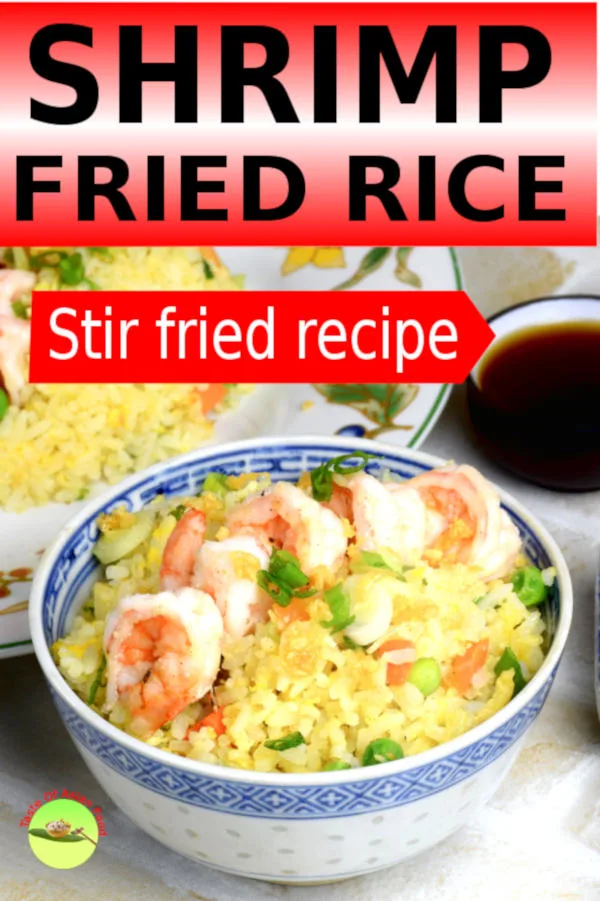
Note: This post may contain affiliate links. Please read my privacy policy for more info. I may receive commissions for purchases made through links in this post. As an Amazon Associate, I earn from qualifying purchases.
There are two parts to this post
- The first part is the video on how to cook Chinese-style fried rice and the complete recipe.
- The second is a collection of ten time-tested techniques that will transform you into an expert.
These tips will elevate the humble fried rice to the next level and turn it into a culinary wonder.
Read on …
All great recipes share a few universal techniques.
- They must-have distinct and well-separated grains.
- The rice should be sticky enough to easily pick up with chopsticks or a spoon.
- The exterior of the grains should be slightly brown, and the interior should remain soft and slightly chewy to bite.
Before we look at the respective recipes, let’s get into the top secrets of how to cook the best fried rice. These secret tips apply to all recipes.
Part 1: Ten secrets you need to know to be a fried rice expert
Although each recipe is different, there are certain important techniques and tricks that are universal. As long as you understand and follow them, you are well on the way to cooking up a fantastic dish every time
1. Use the right type of rice
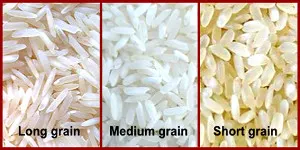
The best type of rice for frying should be less starchy, fragrant, and have a chewy texture.
- Medium-grain rice boasts a great balance of chewiness and the ability to maintain the shape of individual grains after frying. Thai fragrant Jasmine rice has a perfect stickiness balance and is not easily mushy. Both have a superior texture and are best for fried rice.
- On the other hand, short-grain sushi rice is stickier and starchier. It is easily clumped together during frying. Unless you are preparing Japanese fried rice, this is not an option to look for.
- Long grain rice, such as Basmati rice, lacks the plumpness of medium grain rice, which results in rice that is dry and hard. That is why Basmathi rice is not a popular choice for frying.
Tips: Medium-grain rice is my choice.
2. Rinse the rice to remove the excess starch
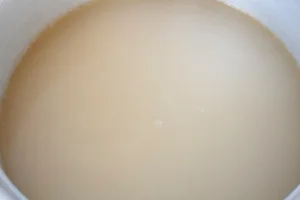
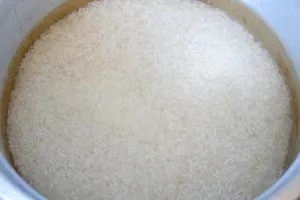
Have you ever wondered what the purpose is of rinsing the rice before cooking?
a. Rinsing the rice serves two purposes:
- Most of the rice in Asia (where I live) is not very clean. The rice should be rinsed to remove husk, sand, and impurities.
- Rinsing will remove the excess starch, the culprit that causes rice grains to clump together while stir-frying.
Therefore, rinsing is far more important for frying rice than cooking white rice or preparing sashimi and risotto, as the stickiness of rice is relevant.
b. How to do it:
- Fill a container with clean water. Put the uncooked rice and stir it with your hand a few times.
- Remove the starchy water and replace it with fresh water. Repeat four to five times until the water runs clear and is no longer starchy.
- Remove as much water as possible, then place the rice in a rice cooker. Add 1.25 cups of water for each cup of dry rice (before rinsing) to cook the rice.
Note that you do not need to rinse so many times if you want to cook plain or biryani rice. Conversely, you do not rinse Arborio rice to make risotto because you want to preserve as much starch as possible.
3. Fluff the rice to separate the grains
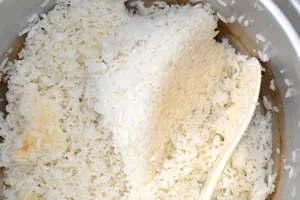
- Fluff the rice as soon as it is cooked, as it tends to harden and solidify into a block when it cools down.
- Check whether the rice grains clump together when you want to fry the rice. If this happens, break up the lumps gently with your hands before frying it because it is hard to break up the rice in the wok.
- You can’t brown the surface if the grains are clumped together. The grains must be separated so the surface can be slightly brown when stir-fried. This step is crucial to creating the wok aroma, or wok-hei, as the Chinese describe.
Tips: Fluffy rice is not only good for fried rice. It is also important to serve with plain steamed rice. Make a habit of fluffing the rice immediately after cooking it.
4. Dry the rice for perfect browning
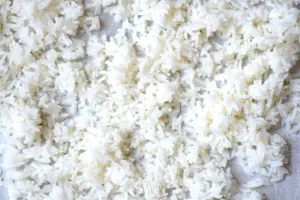
A plate of perfect fried rice should have a slightly charred surface and a soft and chewy interior. The surface of the rice grains should be dry enough to get a good browning effect while frying.
The rice will stick together and not brown efficiently if the surface is wet.
Fried rice cooked with normal water is unsuitable as it will clump together easily. The solution is to cook the rice with slightly less water than normal. The rice with lower water content will also avoid the problem of sticking to the wok during stir-frying. A well-seasoned wok is the best cookware to avoid sticking yet able to handle high heat.
Tips:
There are two ways to keep the surface of the rice dry and achieve a good browning effect.
- Use overnight rice. Traditional Chinese chefs prefer to use overnight rice to prepare fried rice. However, cold rice (leftover rice) stored in the refrigerator tends to clump together. Also, it tends to lose moisture not only on the surface but also in the interior of the grains. As a result, it tends to be harder and less chewy. Also, the rice should return to room temperature before frying because it can be quite clumpy when it is cold.
- Blow the freshly cooked rice under the fan. Fluff and spread the fresh rice thinly on a tray or baking sheet. Blow it under a fan until the rice is dry enough on the surface. However, make sure the rice is not too dry and turns hard. Otherwise, the fried rice will be just as hard as the day-old rice. This method gives better control over the moisture content than the overnight rice left in the fridge. The rice is also fresh, not stale, like overnight rice.
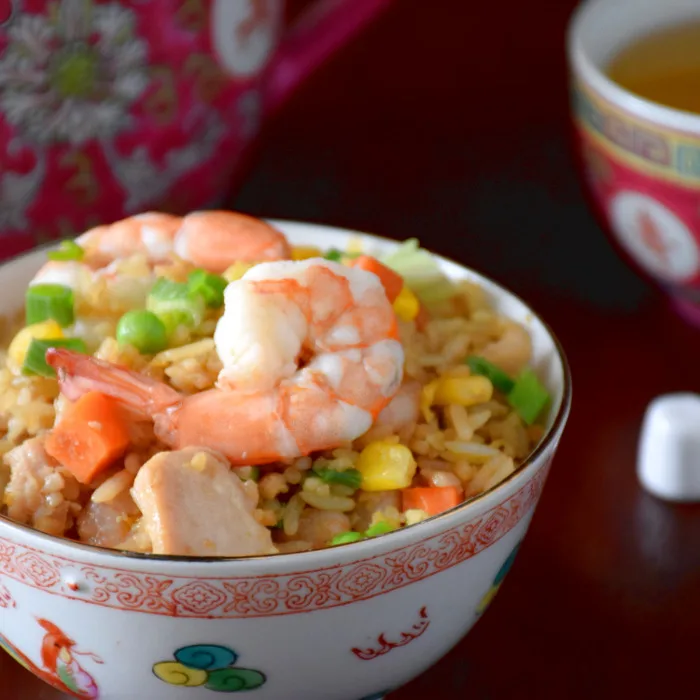
5. Use seasoning sparingly

Generally, fried rice should be seasoned with a small amount of soy sauce, salt, ground white pepper, oyster sauce, or fish sauce. The flavor of the rice should be highlighted, not the seasonings. While it is generally recommended that it doesn’t need a ton of sauce, Indonesian nasi goreng contains a large amount of chili paste and sweet soy sauce. The following list shows what seasonings are used normally, but there are still plenty of variations in different regions of the world.
- Chinese fried rice– Premium light soy sauce and dark soy sauce are used. Some chefs prefer just a pinch of salt to keep the bright color of the rice. If you use too much soy sauce or oyster sauce, the color of the rice will become dark and not aesthetically appealing. Premium light soy sauce tastes much better than the regular soy sauce for preparing it.
- Chinese-American fried rice– tomato ketchup, and Worcestershire sauce are used to render a whole new flavor. You will likely see bell peppers and sausages in the recipe.
- Thai fried rice– uses fish sauce, soy sauce, and sugar.
- Japanese fried rice– Mirin (sweet Japanese cooking wine), Japanese soy sauce.
- Indonesian nasi goreng– sambal (Indonesian chili paste)
Despite the differences, the key to making the fried rice smell aromatic is keeping the rice dry during stir-frying. Therefore adding the wet seasoning gradually to keep the rice dry is the best practice.
6. Add an egg for better flavor
Eggs are the essential ingredients for fried rice. The simplest egg fried rice (鸡蛋炒饭) only required egg and light soy sauce, which is a delectable meal by itself. This is analogous to a masterfully prepared plain agleo e oleo spaghetti with only olive oil and garlic. Its success depends on the cook’s skill, nothing less, as there are no other ingredients to enhance the flavor.
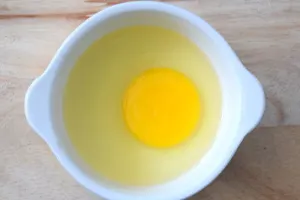
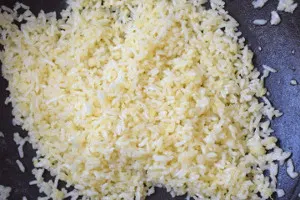
There are different ways to use eggs for fried rice
a. Fried and egg.
Just fry an egg (normally an easy-over egg) and put it on a plate of fried rice. This is how Indonesian nasi goreng is usually presented. Since Indonesian fried rice contains plenty of chilies, it does not matter that the eggs are not mixed into the rice.
b. Coat the rice with eggs.
- Fry the rice in the wok until the grains are slightly brown and smell fragrant.
- Turn down the heat, pour the beaten eggs into the rice and mix well. Continuously on low heat until the eggs are fully cooked. (To avoid sticking to the wok, be sure not to turn the heat up before the eggs are cooked.)
- Once the eggs dry, add the soy sauce, seasonings, and other ingredients.
- Stir fry on intense heat for a minute to create wok-hei.
This method enhances the flavor of all rice grains with eggs, much like a fish fillet covered in batter. It is a little more technical but worth the time to perfect the technique.
c. Break up the omelet. Push the rice to the side of the wok. Pour some oil into the bottom and add a whisked egg to make an omelet. Use a wok spatula to break the cooked eggs into small pieces and mix them with the rice. This method is common to add an egg to most fried rice recipes.
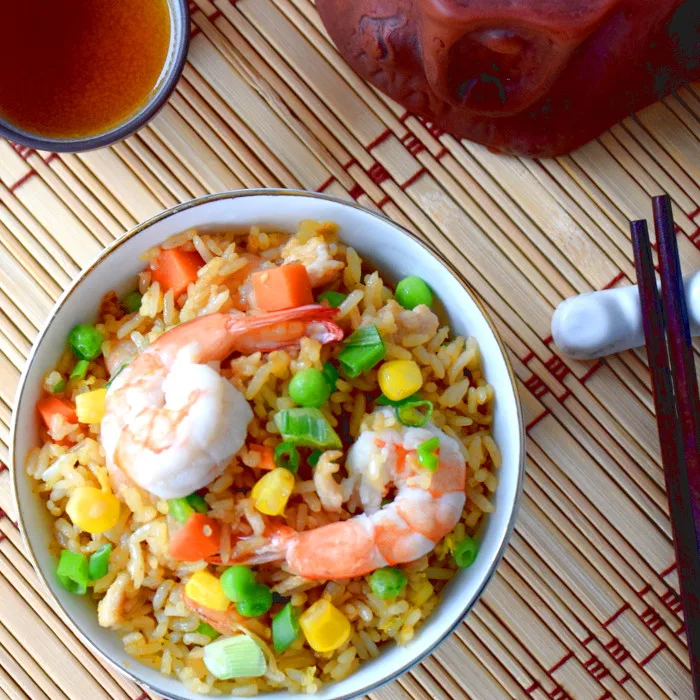
7. Use a wok to fry (and what if you do not have one?)
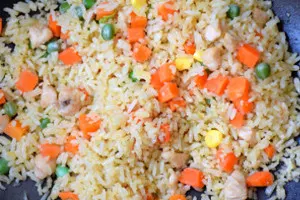
a. Fry with a wok
A cast-iron or carbon steel wok is the best cooking utensil for fry rice. The wok has different heat zones that make controlling temperature an easy task. Its spherical shape makes tossing and flipping a snap, with little chance of food pieces falling out as they would from a flat pan. It sits perfectly on the wok burners that can generate intense heat to produce plenty of wok hei.
However, the wok is not designed to be used on Western-style burners. Stove tops with induction or a heating coil cannot generate as much heat as a wok burner. These are the limitations most home cooks face when trying to replicate the restaurant’s standard fried rice.
There is a workaround, albeit it’s not perfect. Below is my tested method.
b. How to use a pan or a large skillet to fry rice
- Use a flat-bottomed wok or pan to place it on a flat stove top.
- Add some oil to the pan and wait until it is piping hot before adding the rice so that the exterior has a chance to brown.
- Use a larger pan than what you think is enough. This will help prevent food from falling out during stir-frying.
- To compensate for the low heat generated by the home burners, stir-fry in small batches. Stir-fry one serving each time so the stove can generate sufficient heat to maintain the heat throughout the stir-frying process. (This is by far the most important thing you should do.)
- Keep tossing and stirring to prevent the rice from sticking to the pan.
8. Choose the best combination of ingredients
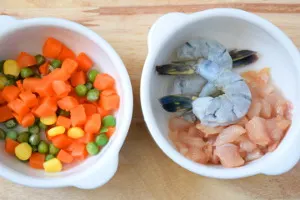
Fried rice is a great way to use up various leftovers. You can make chicken fried rice or shrimp fried rice out of your leftovers, but the following guideline applies to all types of fried rice.
How to prepare the ingredients for fried rice
- Cut the ingredients into smaller pieces. All the vegetables, meat, and seafood should be in small pieces to be cooked quickly.
2. Choose something that can maintain the shape and won’t fall apart with constant flipping and tossing. (This implies that fish meat is not quite suitable. )
3. The egg is the best ingredient for fried rice. It enhances the flavor of all types of fried rice.
4. Use aromatics. Saute the aromatics (garlic, onions, spring onion) with oil. The aromatic oil enhances the flavor of the rice, just like infusing garlic flavor into the oil for a plate of aglio e oleo pasta.
5. Use less liquid. Use a small amount of liquid (soy sauce, fish sauce, etc). Adding water is a definite ‘no.’
6. Chicken, pork, char siu, and beef should be sliced thinly. Prawns and crab meat are good alternatives. Fish meat is not suitable as it will fall apart while stir-frying.
7. Vegetables. It depends on the recipes. Chinese fried rice includes chopped spring onions (green onions) sprinkled on top, whilst Thai fried rice may prefer basil. A mix of frozen green peas, corn, and diced carrots is a convenient combination to add shapes and colors.
9. Use the right oil to fry rice

The choice of oil for fried rice plays an important part in creating authentic Asian flavor. Oils suitable for stir-frying are vegetable oil such as peanut and palm oil. They have a high smoking point suitable for stir-frying and a neutral taste that will not affect the flavor of the fried rice.
Olive oil and butter are not suitable for cooking oriental fried rice. They do not have a neutral flavor, and the smoking point is relatively low.
10. Fry on the highest heat
There are many ways to fry rice. The proponent of each method vouches that they have the best method. The reality is that there is no ‘best’ method, as it is a matter of personal preference.
However, producing wok-hei is crucial and is often used to measure a Chinese chef’s credibility.
When cooked correctly, the fried rice is said to “have wok hei 有镬气. “To impart wok-hei, the food must be cooked in a hot wok over intense heat while being stirred and tossed quickly. In short, stir-fry the rice on high heat whenever possible.
Part 2: Selected list of fried rice
I published a list of fried rice recipes on this blog. There have different tastes but are still based on all the techniques in Part 1.
- Basil fried rice. This fried rice is popular in Thailand, with basil leaves as the main ingredients to give it a unique flavor.
- Bacon fried rice. This recipe is not conventional Chinese-style fried rice. However, stir-fry over roaring heat generates the signature wok aroma and bursts with the incredible bacon flavor.
- Japanese fried rice with garlic. Simple ingredients, quick and easy cooking technique, and delicious upon delicious.
- Nasi goreng kampung. If you like fried rice, you must not miss the Indonesian and Malay versions called nasi goreng.
- Chinese Sausage Fried Rice. This dish serves as a welcome respite from the elaborate cuisine and binge eating during the Chinese New Year.
- Pineapple Fried Rice. Traditional Thai fried rice is served in the beautifully crafted pineapple bowl.
- Yang Chow fried rice. The most famous Chinese fried rice in the world.
- Shrimp fried rice. A popular fried rice dish you must try. I improvise the shrimp fried rice served in a Michelin awarded restaurant.
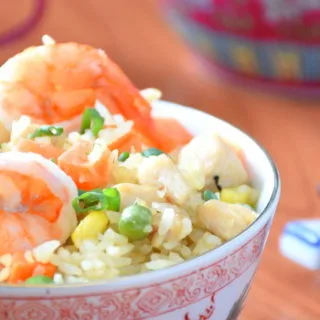
Chicken and shrimp fried rice
This is the simple fried rice recipe of restarant quality that you make it at home.
Ingredients
- 2 tablespoons vegetable oil
- 1 teaspoon chopped garlic
- 250 g of cooked rice
- 1 egg
- 20 g of shrimp, deveined, remove the shell
- 50 g of chicken breast meat, cut into thin slices
- 50 g frozen mixed beans
- 1 tablespoon of premium grade light soy sauce
- 1 tablespoon of chopped scallion
Instructions
- Heat up the vegetable oil in a wok or large saucepan.
- Saute the minced garlic until aromatic.
- Add the shrimps, follow by the chicken meat and stir-fry until they are cooked. Remove the shrimps and meat. Leave the remaining oil in the wok.
- Add the cooked rice and stir-fry over low heat until the rice turns aromatic, spluttered and sizzled.
- Beat an egg. Pour the egg over the rice.
- Coat the rice grains with the egg. Continue stir fry until the egg is cooked and no longer sticky.
- Return the shrimps and chicken to the wok. Stir-fry for a minute.
- Add the beans and the light soy sauce. Stir-fry over high heat until the rice becomes dry again.
- Sprinkle the chopped scallion on it and serve.
Recommended Products
As an Amazon Associate and member of other affiliate programs, I earn from qualifying purchases.
-
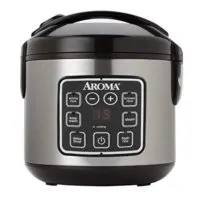 Aroma Housewares ARC-914SBD 2-8-Cups (Cooked) Digital Cool-Touch Rice Cooker and Food Steamer, Stainless Steel
Aroma Housewares ARC-914SBD 2-8-Cups (Cooked) Digital Cool-Touch Rice Cooker and Food Steamer, Stainless Steel -
 Joyce Chen 21-9972, Classic Series Carbon Steel Wok Set, 4-Piece, 14-Inch Charcoal
Joyce Chen 21-9972, Classic Series Carbon Steel Wok Set, 4-Piece, 14-Inch Charcoal -
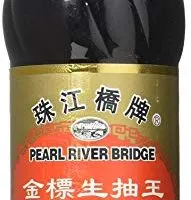 Pearl River Bridge Golden Label Superior Light Soy Sauce, Plastic Bottles, 16.9 oz
Pearl River Bridge Golden Label Superior Light Soy Sauce, Plastic Bottles, 16.9 oz -
 Alpine Cusine BS-400 Propane Burner
Alpine Cusine BS-400 Propane Burner
Nutrition Information:
Yield: 1 Serving Size: 1Amount Per Serving: Calories: 986Total Fat: 36gSaturated Fat: 5gTrans Fat: 1gUnsaturated Fat: 29gCholesterol: 271mgSodium: 1524mgCarbohydrates: 116gFiber: 6gSugar: 2gProtein: 45g
This data was provided and calculated by Nutritionix on 5/28/2019

Discover the Luxury of Premium Fried Rice Recipes – My Blog
Friday 24th of January 2025
[…] experience. Whether you’re planning a special dinner or treating yourself to something indulgent, luxury fried rice recipes are a perfect choice to elevate your dining […]
George Moy
Sunday 16th of April 2023
I told a friend the other day if you want fried rice that taste good,use corn oil or vegetable oil, don’t use olive oil because it leaves your rice taste like olive where other oils doesn’t leave a flavor you wouldn’t want.
John
Tuesday 28th of February 2023
Nice one I love this great cooking
Darthie Lee Davenport
Thursday 29th of July 2021
Used a wide range of your recommended cooking and prep techniques and my meal turned out absolutely splendid!
Laurie Rasor
Wednesday 21st of July 2021
Have A Good Day